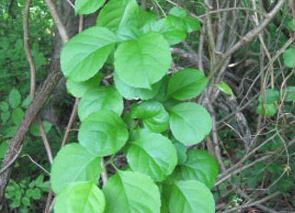
Consider Alternatives When Decorating this Season; Avoid Using Material from Invasive Plants
The Connecticut Department of Energy and Environmental Protection (DEEP) is asking Connecticut residents and decorators to consider alternatives to invasive plants, such as Oriental bittersweet, this holiday season.
Oriental bittersweet (Celastrus orbiculatus) has sometimes been used in holiday decorations, including wreaths. Unfortunately Oriental bittersweet is a highly invasive woody vine that can wrap around trees, damaging and sometimes killing them. The extra weight from Oriental bittersweet on limbs can also cause limb drop, contributing to damage and power outages. Use of the vines in decorations helps spread seeds of the plant to new locations. Additionally, improper disposal of the decorations, either outdoors or in compost after the holiday season, can contribute to the spread of bittersweet.
“There are many alternatives to invasive plants that may be used for holiday decorations,” said Peter Picone, a Habitat Management Program Biologist for the DEEP Wildlife Division. “Often, local florist and greenhouse growers are able to provide attractive and interesting alternatives to bittersweet and other invasive plants. These include native plants that are not invasive, such as winterberry holly. Selling or moving Oriental bittersweet is also prohibited by state law.”
The law, which went into effect in 2004, prohibits the moving, selling, purchasing, transplanting, cultivating or distributing of 80 invasive plant species, including Oriental bittersweet, in Connecticut. This prohibition extends to seeds, flowers, and other reproductive portions of the plants. Fines for violations of the law are listed at $50 per plant.
Individuals who find invasive plants such as bittersweet for sale in Connecticut are asked to contact the DEEP or the Connecticut Invasive Plant Working Group at UCONN. They also are advised not to compost any holiday decorations that contain one or more of the 97 invasive, non-native plants identified in Connecticut. The list can be found at www.eddmaps.org/ipane/ctcouncil/CT_Invasive_Plant_List.htm.
More information about Oriental bittersweet and other invasive plants in Connecticut can also be found at www.cipwg.uconn.edu.
*Image courtesy of USDA
N